Helping your baby learn to walk involves creating a safe and stimulating environment, offering support, and encouraging exploration. At LEARNS.EDU.VN, we understand this exciting milestone and offer expert advice to guide you. This article provides actionable strategies and insights into baby’s walking development, fostering confidence and mobility. Discover valuable resources on baby development milestones and effective parenting techniques at LEARNS.EDU.VN. Let’s explore the world of infant mobility, toddler development, and early childhood education.
1. When Do Babies Typically Start Walking?
Babies typically start walking between 9 and 18 months old, with an average age of around 12 months. However, this timeline varies significantly from child to child. It’s essential to remember that every baby develops at their own pace, and comparing your child to others can cause unnecessary anxiety. Instead, focus on providing a supportive environment that encourages exploration and movement.
1.1. Factors Influencing Walking Age
Several factors can influence when a baby starts walking, including:
- Genetics: Family history can play a role in when a baby reaches developmental milestones.
- Temperament: Some babies are more cautious and prefer to observe before taking action, while others are more adventurous and eager to explore.
- Muscle Strength: Adequate development of leg and core muscles is crucial for walking.
- Motivation: A baby’s desire to reach objects or explore their surroundings can motivate them to walk.
- Environment: A safe and stimulating environment can encourage a baby to practice walking.
1.2. The Importance of Individual Development
Understanding that each baby develops at their own pace is crucial for parents. According to a study by the American Academy of Pediatrics (AAP), developmental milestones are guidelines, not rigid rules. The AAP emphasizes that focusing on individual progress and providing a nurturing environment is more important than adhering to a strict timeline. So, rather than being concerned with your child’s walking age, focus on nurturing their natural curiosity.
2. Pre-Walking Milestones: The Foundation for Walking
Before a baby takes their first steps, they go through several essential pre-walking milestones that build the necessary strength, coordination, and balance. These stages are crucial for developing the skills needed for walking.
2.1. Crawling
Crawling typically begins around 7 to 10 months. It is a significant milestone that helps develop coordination and strength in the arms, legs, and core muscles.
2.2. Pulling Up to Stand
Around 8 to 12 months, babies start pulling themselves up to stand using furniture or other stable objects. This milestone strengthens their leg muscles and improves their balance.
2.3. Cruising
Cruising involves walking while holding onto furniture or other objects for support. This stage usually occurs between 9 and 13 months and helps babies develop the balance and coordination needed for independent walking.
2.4. Standing Alone
Before taking their first steps, babies often practice standing alone for short periods. This demonstrates increased strength and balance and builds confidence.
2.5. How to Encourage Pre-Walking Milestones
- Provide a Safe Environment: Ensure the environment is safe for crawling, pulling up, and cruising by removing hazards and padding sharp corners.
- Offer Opportunities for Movement: Give your baby plenty of time to move freely and explore their surroundings.
- Encourage Reaching and Grasping: Place toys and other objects slightly out of reach to motivate your baby to move towards them.
- Support and Assist: Help your baby practice pulling up and cruising by providing support when needed and celebrating their efforts.
3. Signs Your Baby Is Ready to Walk
Recognizing the signs that your baby is ready to walk can help you provide the right support and encouragement at the right time.
3.1. Increased Balance and Coordination
A baby ready to walk will show improved balance and coordination. They can stand alone for longer periods and may take a few steps without support.
3.2. Desire to Explore
A strong desire to explore and move around is a key indicator. Your baby may reach for objects further away and show frustration when they can’t reach them.
3.3. Walking with Support
If your baby is confidently cruising along furniture or walking while holding your hands, they are likely close to walking independently.
3.4. Confidence and Enthusiasm
A baby who is excited and confident about moving around is more likely to take those first steps. Encourage their enthusiasm with praise and support.
4. Creating a Safe and Stimulating Environment
A safe and stimulating environment is essential for encouraging your baby to walk. It provides the freedom to explore and practice without the risk of injury.
4.1. Childproofing Your Home
- Padding Sharp Corners: Cover sharp corners of furniture with padding to prevent injuries.
- Securing Furniture: Secure tall or unstable furniture to the wall to prevent it from tipping over.
- Removing Hazards: Remove small objects, cords, and other hazards that could cause choking or tripping.
- Using Safety Gates: Install safety gates at the top and bottom of stairs to prevent falls.
4.2. Creating a Play Area
- Designate a Safe Space: Create a designated play area where your baby can move freely without hazards.
- Provide Soft Surfaces: Use soft rugs or mats to cushion falls.
- Offer Variety: Include a variety of toys and objects to stimulate your baby’s interest and encourage movement.
4.3. The Role of Outdoor Play
Outdoor play provides additional opportunities for exploration and movement. Ensure the outdoor area is safe and supervised, and provide appropriate footwear.
5. Encouraging Your Baby’s First Steps: Practical Tips
There are many practical ways to encourage your baby’s first steps. These methods focus on creating a supportive environment and offering the right kind of assistance.
5.1. Using Push Toys
Push toys, such as small carts or toy lawnmowers, can provide the support and stability a baby needs to practice walking.
- Choose Sturdy Toys: Select toys that are sturdy and won’t tip over easily.
- Ensure Proper Height: The handle should be at a comfortable height for your baby to grip.
- Supervise Play: Always supervise your baby while using push toys to prevent accidents.
5.2. Tempting Trails
Place toys or other objects slightly out of reach to encourage your baby to take steps towards them. This can motivate them to practice walking.
- Use Favorite Toys: Use your baby’s favorite toys to increase their motivation.
- Create a Clear Path: Ensure there is a clear and safe path for your baby to walk.
- Offer Encouragement: Praise and encourage your baby as they reach for the objects.
5.3. Hand-Holding Assistance
Holding your baby’s hands while they walk can provide the support and confidence they need to take their first steps.
- Maintain a Comfortable Grip: Hold their hands gently but firmly.
- Adjust to Their Pace: Walk at a pace that is comfortable for your baby.
- Gradually Reduce Support: As your baby gains confidence, gradually reduce the amount of support you provide.
5.4. Barefoot Walking
Allowing your baby to walk barefoot indoors can help strengthen their feet and ankle muscles, improving balance and coordination.
- Ensure a Safe Surface: Make sure the floor is clean and free of hazards.
- Use Non-Slip Socks: If the floor is slippery, use non-slip socks to provide traction.
- Monitor Temperature: Ensure the floor is not too cold.
5.5. Creating Opportunities for Practice
Provide plenty of opportunities for your baby to practice walking in a safe and supportive environment. The more they practice, the more confident they will become.
- Regular Playtime: Incorporate walking practice into your baby’s regular playtime.
- Encourage Exploration: Encourage your baby to explore different areas of your home or outdoor space.
- Celebrate Successes: Celebrate every step and milestone to reinforce positive behavior.
6. Common Challenges and How to Overcome Them
As your baby learns to walk, they may encounter challenges such as fear, frustration, and falls. Understanding these challenges and how to address them can help you support your baby through the process.
6.1. Fear and Hesitation
Some babies may be hesitant or fearful about taking their first steps. It’s important to be patient and provide reassurance.
- Offer Gentle Encouragement: Encourage your baby without pressuring them.
- Create a Positive Environment: Make walking practice fun and enjoyable.
- Provide Physical Support: Offer your hand or a stable object for support.
6.2. Frustration
Babies may become frustrated when they can’t walk as easily as they want to. Help them manage their frustration by offering praise and support.
- Acknowledge Their Feelings: Let them know that it’s okay to feel frustrated.
- Break Down the Task: Break the task of walking into smaller, more manageable steps.
- Celebrate Small Victories: Celebrate even small steps to boost their confidence.
6.3. Falls and Bumps
Falls and bumps are a normal part of learning to walk. Ensure the environment is safe and supervise your baby closely.
- Childproof the Environment: Remove hazards and pad sharp corners.
- Stay Close: Stay close to your baby to catch them if they fall.
- React Calmly: React calmly to falls to avoid scaring your baby.
7. The Role of Footwear: Shoes vs. Barefoot
The type of footwear a baby wears can impact their walking development. Understanding the benefits of barefoot walking and when to introduce shoes is important.
7.1. Benefits of Barefoot Walking
- Strengthens Muscles: Barefoot walking helps strengthen the muscles in the feet and ankles.
- Improves Balance: It improves balance and coordination by allowing the baby to feel the ground.
- Enhances Sensory Development: It enhances sensory development by providing tactile feedback from the environment.
7.2. When to Introduce Shoes
Shoes are necessary when walking outdoors to protect the feet from injury and the elements.
- Choose Lightweight and Flexible Shoes: Select shoes that are lightweight and flexible to allow natural movement.
- Ensure Proper Fit: Make sure the shoes fit properly and don’t restrict movement.
- Avoid Stiff Soles: Avoid shoes with stiff soles that can hinder foot development.
7.3. Socks with Grips
Socks with grips can provide traction on slippery surfaces indoors while still allowing the benefits of barefoot walking.
8. The Importance of Patience and Positive Reinforcement
Patience and positive reinforcement are key to helping your baby learn to walk. Every child develops at their own pace, and encouragement can make a big difference.
8.1. Understanding Individual Timelines
Recognize that every baby develops at their own pace. Avoid comparing your baby to others and focus on their individual progress.
8.2. Offering Encouragement
Provide plenty of encouragement and praise to motivate your baby. Celebrate every step, no matter how small.
8.3. Avoiding Pressure
Avoid putting pressure on your baby to walk before they are ready. This can lead to frustration and anxiety.
9. When to Seek Professional Advice
While most babies learn to walk within a normal range, there are times when seeking professional advice is necessary.
9.1. Delayed Walking
If your baby is not walking by 18 months, it’s a good idea to consult with your pediatrician. They can assess your baby’s development and identify any potential issues.
9.2. Uneven Development
If you notice that your baby is favoring one side of their body or has difficulty moving one leg or arm, consult with your pediatrician.
9.3. Other Concerns
If you have any other concerns about your baby’s development, such as stiffness, muscle weakness, or coordination problems, seek professional advice.
9.4. Resources Available at LEARNS.EDU.VN
At LEARNS.EDU.VN, we offer a range of resources to support parents through their child’s developmental milestones, including articles, guides, and expert advice. Our goal is to provide you with the information and support you need to help your child thrive.
10. Frequently Asked Questions (FAQs)
10.1. Is it normal for my baby to skip crawling and go straight to walking?
Yes, it is perfectly normal for some babies to skip crawling and go straight to walking. Crawling is not a mandatory developmental milestone.
10.2. How can I encourage my baby to walk if they seem scared?
Offer gentle encouragement, create a positive environment, and provide physical support to help your baby feel more confident.
10.3. What are the best shoes for a baby who is just learning to walk?
The best shoes are lightweight, flexible, and have a non-slip sole. Avoid shoes with stiff soles or heavy support.
10.4. Should I use a baby walker to help my baby learn to walk?
No, baby walkers are not recommended. The American Academy of Pediatrics advises against them because they can be dangerous and may hinder development.
10.5. How much practice should my baby get each day?
Aim for several short practice sessions throughout the day, focusing on fun and exploration rather than structured training.
10.6. What should I do if my baby keeps falling?
Ensure the environment is safe and stay close to your baby to catch them if they fall. React calmly to avoid scaring them.
10.7. When should I be concerned if my baby isn’t walking yet?
If your baby is not walking by 18 months, consult with your pediatrician to rule out any underlying issues.
10.8. What are the best push toys to help my baby learn to walk?
Choose sturdy push toys with a wide base and a handle at a comfortable height for your baby to grip.
10.9. How can I make walking practice more fun for my baby?
Use favorite toys, sing songs, and offer lots of praise and encouragement to make walking practice more enjoyable.
10.10. Can walking too early cause any problems for my baby?
Walking early is generally not a problem as long as your baby is developing normally and has adequate muscle strength and balance.
Learning to walk is a significant milestone in your baby’s development. By creating a safe and stimulating environment, offering support, and encouraging exploration, you can help your baby reach this milestone with confidence. Remember to be patient, celebrate every step, and seek professional advice if you have any concerns.
At LEARNS.EDU.VN, we are dedicated to providing parents with the resources and support they need to navigate the joys and challenges of raising children. Visit our website at learns.edu.vn to explore our comprehensive collection of articles, guides, and expert advice on child development, parenting tips, and educational resources. For personalized support and answers to your questions, contact us at +1 555-555-1212 or visit our location at 123 Education Way, Learnville, CA 90210, United States. Let us help you create a bright future for your child!
Table: Walking Milestones and Encouragement Tips
| Milestone | Age Range (Months) | Encouragement Tips |
|---|---|---|
| Crawling | 7-10 | Provide safe space, encourage reaching |
| Pulling Up to Stand | 8-12 | Offer support, place toys on elevated surfaces |
| Cruising | 9-13 | Arrange furniture for easy access, encourage movement |
| Standing Alone | 10-14 | Praise efforts, create a stable environment |
| First Steps | 12-18 | Use push toys, offer hand-holding assistance, encourage barefoot walking |
| Seeking Professional Advice | 18+ | Consult pediatrician if delayed, uneven development, or other concerns |



This table summarizes key milestones in a baby’s journey to walking and provides practical encouragement tips for each stage.
Latest Updates in Child Development (2024)
| Area | Update | Source |
|---|---|---|
| Motor Skills Development | Emphasis on early intervention programs and personalized approaches to address motor delays. Research indicates that tailored exercises and activities can significantly improve outcomes. | American Academy of Pediatrics (AAP) |
| Technology in Education | Integration of interactive apps and digital tools to support motor skill development. These tools offer engaging ways for children to practice coordination and balance. | National Association for the Education of Young Children (NAEYC) |
| Parent Education | Enhanced resources for parents on creating supportive home environments that encourage physical activity and exploration. Focus on the importance of unstructured play and minimizing screen time. | Centers for Disease Control and Prevention (CDC) |
| Inclusive Practices | Growing awareness of the need for inclusive practices to support children with diverse abilities. Adaptations and modifications to activities ensure that all children can participate and develop motor skills at their own pace. | Council for Exceptional Children (CEC) |
| Nutrition and Health | Recognition of the critical role of nutrition in supporting motor skill development. Guidelines emphasize the importance of a balanced diet rich in essential nutrients for optimal muscle and bone growth. | World Health Organization (WHO) |
This table highlights recent advancements and trends in child development, emphasizing personalized approaches, technology integration, parent education, inclusive practices, and the role of nutrition in supporting motor skill development.
By following these guidelines, you can create a supportive environment and encourage your baby to take those first steps with confidence. Remember to celebrate every milestone and enjoy the journey!
